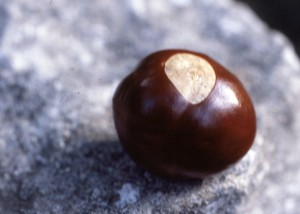During the football season, we are accustomed to seeing Brutus Buckeye dancing on the sidelines, shaking his enlarged head, and helping to stimulate enthusiasm for our team on the gridiron. Opposing teams usually have mascots that are more easily recognizable, such as a lion, or badger, or valiant soldier. What, then, is a buckeye?
The term “buckeye” originated from indigenous peoples noticing that European immigrants coming into Ohio had larger eyes, similar to those of the male (buck) deer. The settlers, therefore, were called buckeyes.
One of the native trees in Ohio, which we now call the Ohio buckeye, has large seeds that also resemble large buck eyes, which led to application of the name as the buckeye tree. This common name was applied to the entire tree and any of its parts. Our mascot, Brutus, represents one seed of the Ohio buckeye tree, attached, obviously, to a human body. This is a most unusual mascot. Most institutions use fierce animals or symbols of strength; very few have a plant. A seed in flowering plants is always formed within a fruit, which in the case of the Ohio buckeye is large, leathery, and slightly prickly. One to several seeds are formed inside. The tree can be up to 30 feet tall, and the leaves are divided into segments.
One of the attractive aspects of the buckeye tree is the colorful display of yellow flower clusters (inflorescences) that appears in late Spring throughout the state. The buckeye is used by The Ohio State University as part of the University seal, showing a leaf with two fruits (Fig. 3).
The Ohio buckeye came into the scientific world as a new species, under the name Aesculus glabra, described by Professor Carl Ludwig Willdenow, Director of the Botanical Garden in Berlin, Germany. Seeds were collected about 1803 from some unknown locality in Ohio or neighboring state and sent to Berlin for germination. It grew successfully in the garden, and when the small tree flowered, a specimen was prepared, with Prof. Willdenow describing it as new to science in 1809. This specimen is called the nomenclatural type (holotype) and is forever associated with its scientific name. In a certain sense, this can be regarded as the original buckeye.
Because of the importance of Aesculus glabra to the state of Ohio and The Ohio State University, a campaign was initiated in 1985 to bring the original buckeye to campus. This was not an easy endeavor, because the Berlin Botanical Garden and Museum had never loaned any of the historically important Willdenow specimens to another institution. After serious negotiations, and in recognition of the help that the United States had made through the Marshall Plan to reconstruction of Germany after World War II, the holotype of the Ohio buckeye was loaned to Ohio State in the summer of 1987 for several months. It was hand carried from Berlin to Columbus. Thanks to financing from the office of the President at OSU, a special mount was made for the specimen, which allowed it to be placed on an easel for display. Housed in the Herbarium of the University, at that time still in the Botany and Zoology building at 12th and Neil Avenue (now Jennings Hall), it was taken on tour to alumni clubs in the state. Most exciting, however, was the presentation of the holotype on 14 November 1987 on the 50-yard line during the Ohio State-University of Iowa home game to the assembled fans. President Jennings formally received the specimen for the University, assisted by me and Prof. Daniel Crawford, the Chair of the Department of Botany. Even Brutus had the opportunity to get to know his scientific origins.
Different parts of the buckeye tree are used as memorabilia or symbols. Very popular are necklaces made of actual seeds, which can be worn in the stadium to help cheer on the players. Also popular, especially to folks with a sweet-tooth, are the buckeye candies resembling seeds, with peanut butter centers bathed in chocolate.
In addition to these obvious symbols, there are countless items in souvenir shops that have images of buckeye seeds and/or leaves, ranging from socks to hats, and including underwear and toilet seats! The football players even receive a buckeye leaf on their helmets, a badge of honor, after completing an outstanding play during the game.
The Ohio buckeye, therefore, is an important part of the fiber of life at Ohio State University. It is satisfying that the center of all the attention is a plant. We in the Herbarium are delighted that all members of the university community are continually reminded of the importance of the botanical sciences, especially in the Autumn season during each football game!
 About the Author: Tod F. Stuessy is Professor Emeritus at the OSU Herbarium.
About the Author: Tod F. Stuessy is Professor Emeritus at the OSU Herbarium.
*** We would like to hear from you – please leave a comment ***






